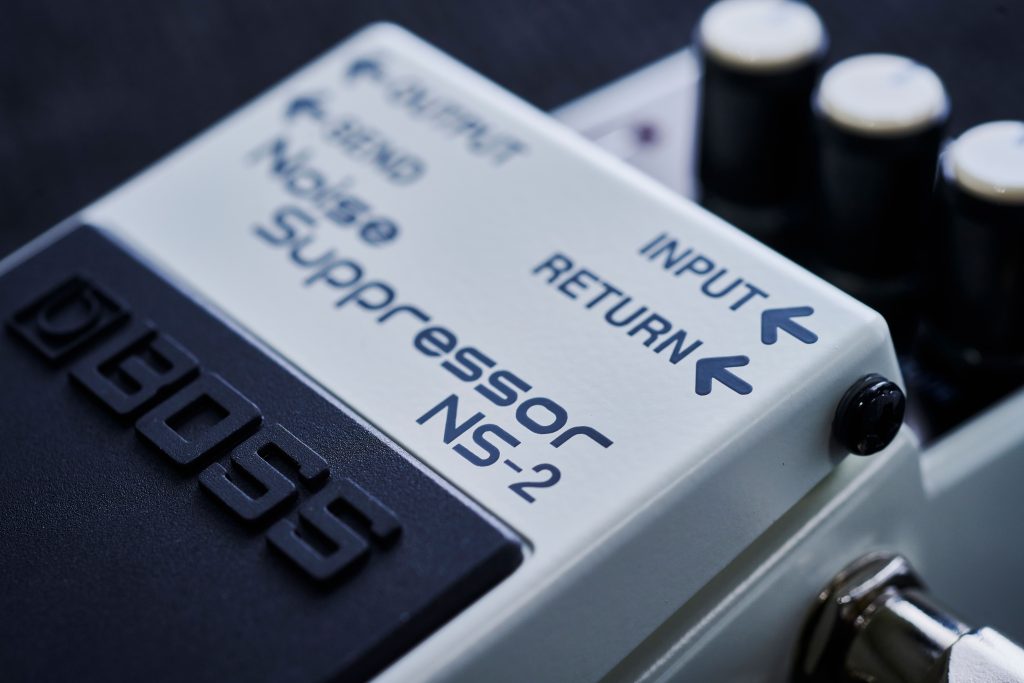What is Noise?
Since the earliest days of the electric guitar, hiss, buzz, and hum in the signal—aka noise—have plagued players. Unwanted sound is a source of irritation for musicians, engineers, and producers alike. (Not to mention audience members.) It comes at us from all angles. Electromagnetic interference from lights, grounding issues, or old-fashioned mains hum. Whatever the source, guitarists have much to contend with.
Luxuries like shielded cables, high-quality power supplies, and humbuckers are now at our disposal. As a result, many of the problems which plagued the guitarist of yesteryear are minimal. Nevertheless, noise remains a real issue for many players. This is particularly true when using large amounts of gain and volume.
"The level of volume at which the NS-2’s gate begins to close and shut off the signal can be set using the Threshold knob."
Noise Suppressor 101
The BOSS NS-2 Noise Suppressor is a studio-quality noise gate in the form of a compact pedal. It is the perfect answer to eliminating any unwanted noise in the signal chain. Noise gates work by automatically turning down or shutting off a signal when it drops to a certain level or threshold where it’s noticeable.
The level of volume at which the NS-2’s gate begins to close and shut off the signal (thereby eliminating noise) can be set using the Threshold knob. Similarly, guitarists can adjust the speed at which it closes using the Decay knob.

Easy and Natural
An excellent way of achieving a natural feel and sound is to plug your instrument directly into the NS-2’s Input. Do this while hooking the amp up to the Output. Then use the Send and Return jacks to patch in effects. This will allow you to control the gate using the dynamics of the guitar itself. Thus, it becomes easier to adjust Threshold and Decay settings for a more transparent result.
However, you may wish to use some effects that rely on fading as part of their inherent character. Reverb and delay are two examples. Place them after the NS-2’s Output to avoid any interference.
Alternately, the Noise Suppressor can go anywhere in a chain of pedals connected via its Input and Output jacks. One popular method involves placing it immediately after a saturated distortion. This creates a tight, gated sound that you can turn on or off as necessary to allow for feedback.
"The Noise Suppressor can go anywhere in a chain of pedals connected via its Input and Output jacks."
Staying in the Loop
When using the NS-2 with an effects loop, it helps to think of the amplifier as having two distinct sections. There’s the preamp, where a majority of the noise is likely to occur, and the power amp. An amp’s effects loop will normally sit between the two. This allows you to patch in pedals after the noise-inducing gain occurs in the preamp.
You can, of course, simply hook the NS-2 up here via its Input and Output jacks. However, you can also position the preamp section within the NS-2’s Send and Return loop. Do so via the pre/amp input and the amp’s effects loop output/send, respectively.
It may be helpful to include gain pedals here while placing reverb and delay after the NS-2’s Output. You can then send the un-gated output to the amplifier’s power amp section via its effects loop input/return. At the same time, you can plug the guitar itself can directly into the NS-2’s Input for more natural gate control.

Tame the Buzz
With these NS-2 tips, you’ll be honing hum and silencing static in no time. Now, place your NS-2 on your pedalboard and bring the noise.






